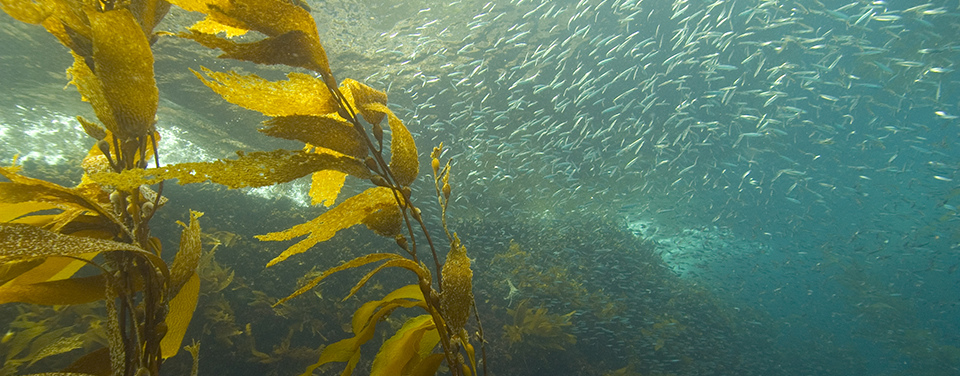What Are Kelp Forests?
December 19, 2024 at 11:48 am
 Kelp forests grow predominantly on the Pacific Coast, from Alaska and Canada to the waters of Baja California. Tiered like a terrestrial rainforest with a canopy and several layers below, the kelp forests of the eastern Pacific coast are dominated by two canopy-forming, brown macroalgae species, giant kelp (Macrocystis pyrifera) and bull kelp (Nereocystis leutkeana).
Kelp forests grow predominantly on the Pacific Coast, from Alaska and Canada to the waters of Baja California. Tiered like a terrestrial rainforest with a canopy and several layers below, the kelp forests of the eastern Pacific coast are dominated by two canopy-forming, brown macroalgae species, giant kelp (Macrocystis pyrifera) and bull kelp (Nereocystis leutkeana).Conditions Required for Growth
Kelp forests grow along rocky coastlines in depths of about 2 m to more than 30 m (6 to 90+ ft). Kelp favors nutrient-rich, cool waters that range in temperature from 5o to 20o C (42o to 72o F). These brown algae communities live in clear water conditions through which light penetrates easily.
Kelp recruits most successfully in regions of upwelling (regions where the ocean layers overturn, bringing cool, nutrient-rich bottom waters to the surface) and regions with continuously cold, high-nutrient waters. Because the amount of dissolved inorganic nitrogen decreases significantly in marine waters warmer than 20oC, kelp experiences reduced or negative growth rates in warm water.
Kelp survival is positively correlated with the strength of the substrate. The larger and stronger the rock on which it is anchored, the greater the chance of kelp survival. Winter storms and high-energy environments easily uproot the kelp and can wash entire plants ashore.
Unique Characteristics of Kelp Plants
Instead of tree-like roots that extend into the substrate, kelp has "anchors" called holdfasts that grip onto rocky substrates. From the holdfasts, kelp plants grow toward the water's surface. Gas bladders called pneumatocysts, another unique feature of kelp, keep the upper portions of the algae afloat. A giant kelp plant has a pneumatocyst at the base of each blade. In contrast, a bull kelp plant has only one pneumatocyst that supports several blades near the water's surface.
Giant kelp is a perennial (it lives for several years) while bull kelp is an annual (it completes its life cycle in one year). Both types of kelp have a two-stage life cycle. They exist in their earliest life stages as spores, released with millions of others from the parent kelp, the sporophyte. The spores grow into a tiny male or female plant called a gametophyte, which produces either sperm or eggs. After fertilization occurs, the embryos may grow into mature plants (sporophytes), completing the life cycle.
Giant kelp can live up to seven years. Factors such as the severity of winter storms may affect its life span. Its average growth (in spring) is 27 cm/day (~10 inches/day), yet it may grow up to 61 cm/day (2 ft/day). The average growth of bull kelp is 10 cm/day (~4 inches/day).
The Kelp Forest Ecosystem
A host of invertebrates, fish, marine mammals, and birds exist in kelp forest environs. From the holdfasts to the surface mats of kelp fronds, the array of habitats on the kelp itself may support thousands of invertebrate individuals, including polychaetes, amphipods, decapods, and ophiuroids.
California sea lions, harbor seals, sea otters, and whales may feed in the kelp or escape storms or predators in the shelter of kelp. On rare occasions gray whales have been spotted seeking refuge in kelp forests from predatory killer whales. All larger marine life, including birds and mammals, may retreat to kelp during storms or high-energy regimes because the kelp helps to weaken currents and waves.
Perhaps the most familiar image of kelp forests is a picture of a sea otter draped in strands of kelp, gripping a sea urchin on its belly. Both sea otters (Enhydra lutris) and sea urchins (Strongylocentrotus spp.) play critical roles in the stable equilibrium ecosystem. Sea urchins graze kelp and may reach population densities large enough to destroy kelp forests at the rate of 30 feet per month. Urchins move in "herds," and enough urchins may remain in the "barrens" of a former kelp forest to negate any attempt at regrowth. Sea otters, playing a critical role in containing the urchin populations, prey on urchins and thus control the numbers of kelp grazers.
